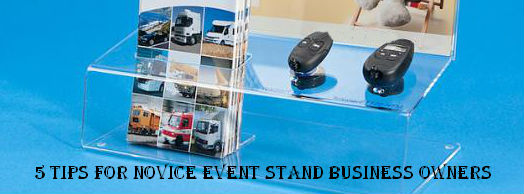Creating an events stand that works as both an effective sales tool and a practical example of the functionality of a brand is something that takes a little practice. It can be tough for new business owners and event first-timers to get everything right from their maiden event.
Assuming a business owner has already done the groundwork – researching the market, assessing the best shows for their products and services, setting exhibition objectives such as meeting 50 new clients etc. – here are five expert tips for fledgeling business owners looking to create an effective display stand at their first event.
1. Invest in display equipment
It’s not essential to spend a lot on a display, but sensible basics like a banner, leaflets, business cards and marketing products are a good idea. The key is to look professional regardless of the size of the business. A few commissioned display items will always look more business-friendly than a pile of posters printed on the home computer.
2. Use display products with long-term marketing reach
It’s a superb trick often used by businesses of all sizes – use display items which can both provide information for potential clients to take away, and also fulfil a marketing need. Things like calendars, pens, carrier bags, mugs, keyrings, smart device covers and credit card holders are practical to the user long-term and great for marketing.
3. Make a clear brand statement
The best stands have a clear message – Who are they? What are their products and services? How can they help potential clients, today? Investing in professional display items like banners and plastic boards is only effective if the brand message is clear and concise.
The new business owner wants to draw people towards the stand so they can explain more about the business.
4. Invest in pre-exhibition marketing and branding
It’s no good investing in a professionally designed events stand emblazoned with business information like a website address if the website isn’t up to scratch. These days, both B2B and B2C interactions are expected to take place, to some degree, on the web.
Pre-events marketing can include things like promoting the event on the company blog and social media accounts. Never promote something that’s not already in place, e.g. the dreaded “website under construction” banner!
5. Learn the lingo
The word “um” has no place in a proactive business environment. An entrepreneur needs to practice their answers to questions about their products and services in advance of the event. Something that falls between scripted answers and quickly thought-out, verbally stimulating responses is ideal.
Setting business objectives can help iron out a few of the kinks when it comes to learning the lingo ahead of time. For example, aiming to make 50 new contacts – exchanging details with a view to working together – will require a different lexicon to simply handing out 200 samples and hoping for the best.
